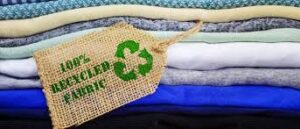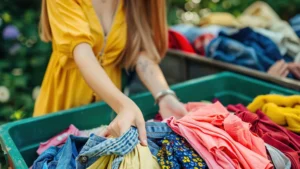One of the most powerful sectors in the world, fashion shapes identity, trends, and culture. But it also has a big impact on the environment. Because it contributes to waste, pollution, and excessive resource consumption, the fast fashion sector in particular is well-known for its negative effects on the environment. Sustainable fashion, which emphasizes minimizing adverse environmental effects while advancing moral production and consumption methods, has surfaced as a response to the growing need for more environmentally conscious living.
Creating an eco-friendly wardrobe doesn’t have to mean compromising on quality or design. Actually, it’s about making deliberate, well-informed choices that are consistent with sustainable ideals, including buying products manufactured from organic materials, endorsing ethical companies, and embracing longevity as opposed to consumption driven by trends. Here’s how to create a wardrobe that embodies these ideas.

Understand the Impact of sustainable Fashion
Understanding how fashion affects society and the environment is crucial for making wise decisions. One of the biggest causes of pollution in the world is the textile sector, which uses hazardous chemicals, generates a lot of trash, and uses a lot of water. A single cotton T-shirt, for instance, requires around 2,700 liters of water to create, which is equivalent to the amount of water a person consumes over the course of 2.5 years. When laundered, synthetic textiles like polyester, which are derived from petroleum, add to the microplastic pollution that harms marine life.
The fashion business is also very concerned with social issues. Many garment workers receive poor pay and endure hazardous working conditions, particularly in developing nations. The fight for fair wages, better working environments, and responsible production processes is at the heart of sustainable fashion.
Prioritize Quality Over Quantity
Buying fewer, better-quality, longer-lasting things is one of the main principles of sustainable fashion. Customers are encouraged by fast fashion to purchase inexpensive, shoddy apparel that frequently breaks after a few wears. Selecting well-made, long-lasting items lessens the need for frequent replacements, which reduces waste and makes your wardrobe more environmentally friendly overall.
Look for clothing made of premium materials like wool, hemp, linen, or organic cotton when you’re shopping. Compared to traditional materials, these are typically more resilient and less harmful to the environment. Additionally, to increase the longevity of your clothing, look for sturdy stitching, well-made seams, and high-quality finishing.
Choose Natural, Organic, and Regenerative Fabrics for Sustainable Fashion

Your wardrobe’s sustainability is greatly influenced by the fabric you choose. For instance, conventional cotton is one of the most resource-intensive textiles since it requires a lot of water and insecticides. However, organic cotton is a far more environmentally responsible choice because it is farmed without dangerous chemicals and frequently consumes less water.
Other sustainable fabrics include:
- Linen: Produced from the flax plant, linen uses less water, is biodegradable, and requires less pesticides during cultivation.
- Hemp: Hemp is a very sustainable plant that is biodegradable, long-lasting, and requires no pesticides or water.
- Recycled Fabrics: By reusing post-consumer materials, fabrics created from recycled polyester or nylon help to cut down on waste.
- Tencel (Lyocell): Produced using a closed-loop method that recycles water and solvents, Tencel is biodegradable, uses less water to make than cotton, and is created from wood pulp that is sourced responsibly.
When purchasing clothes, opt for items made from these sustainable materials whenever possible.
Support Ethical Brands
Supporting companies that put ethics and sustainability at the forefront of their manufacturing processes is one of the most effective methods to create an eco-friendly wardrobe. Fair salaries, ethical labour methods, and open supply chains are the main focusses of many sustainable fashion firms. These businesses also frequently employ eco-friendly textiles and implement waste reduction programs like upcycling or zero-waste designs.
Use certifications like Fair Trade, GOTS (Global Organic Textile Standard), and B Corp to identify ethical fashion brands. These certifications guarantee that businesses adhere to certain social and environmental standards. You may learn more about how your clothing is created and the effects it has on people and the environment by looking into the company’s supply chain and production practices.
Buy Second-Hand and Vintage Clothing to help Sustainable Fashion
One of the best methods to lessen your impact on the environment is to purchase used clothing. By lowering the need for new clothes, the second-hand market contributes to a reduction in the trash that rapid fashion produces. You can find unique items and support the circular economy by shopping at thrift stores, consignment stores, or online marketplaces like Depop, Poshmark, or ThredUp.
Adding classic pieces to your collection is especially easy with vintage clothing. In addition to being more environmentally friendly, it may be an enjoyable and imaginative way to try out different styles without having to follow the newest fads. Furthermore, a lot of vintage items are constructed from premium materials that have endured, guaranteeing their wearability for many years to come.
Learn to Care for Your Clothes
Proper maintenance can greatly increase the longevity of your clothing and lessen the need for frequent replacements. Unknowingly, a lot of individuals ruin their clothes by washing and drying them incorrectly. Take these easy actions to make sure your clothing lasts longer:
- Wash less frequently: Unless an item is obviously filthy, try to wear it several times before washing it to avoid causing fabric to deteriorate.
- Use cold water: Cold water washing conserves energy and helps protect fabric.
- Let your items air dry because tumble drying can weaken the fabric and cause it to shrink. Lay your clothing flat or hang them up to air dry whenever you can.
- Keep in mind that excessive ironing can harm textiles, particularly synthetic ones. Instead, try hanging or steaming your garments to get rid of creases.
- Avoid tossing away damaged clothing by attempting to fix it instead of throwing it away. You can mend loose seams, fix tiny holes, or even turn something into something else entirely.
Adopt a Mindful Approach to Shopping
Creating an eco-friendly wardrobe involves more than simply the items you purchase; it also involves how and why you shop. Taking a conscious approach to shopping entails challenging your buying patterns and putting more emphasis on sustainability, quality, and necessity than on impulsive purchases.
Ask yourself things like:
- Do I really need this item?
- Will I wear it regularly, or is it just a passing trend?
- Is the item made from sustainable materials?
- Does the brand prioritize ethical and environmental standards?
Think about following the 30-day rule, which states that you should wait 30 days before making a purchase if you’re not convinced about it. You can then decide if the item is really necessary and if it fits with your sustainable wardrobe goals.
Reduce, Reuse, Recycle approach for Sustainable Fashion
Creating an eco-friendly wardrobe is more than just purchasing new things. Additionally, it entails cutting back on your overall consumption and figuring out how to recycle and reuse the clothing you already own. Think about the following choices before throwing away things that are no longer useful to you:
- Donate: Donate clothes that are in good condition to charity shops or local organizations.
- Upcycle: Get creative and repurpose old clothing into something new. You can turn an old shirt into a tote bag or transform a worn-out pair of jeans into shorts.
- Recycle: If your clothes are beyond repair or donation, consider recycling them. Many fabric recycling programs and clothing brands offer take-back schemes to recycle old garments into new fabrics.
Be a Conscious Consumer
Being a conscientious consumer is ultimately the key to creating an eco-friendly wardrobe. Individuality is expressed via fashion, and you can help create a more ethical and responsible industry by choosing sustainable, well-considered styles. Creating a wardrobe that reflects your ideals will benefit the globe in addition to making you feel good about the clothes you wear.
You may design a wardrobe that demonstrates your dedication to sustainability by putting quality first, buying from ethical companies, cutting back on consumption, and taking good care of your clothing. Sustainable options will always be popular, even if fashion changes.
Sustainable Fashion in India

One of the biggest manufacturers and consumers of textiles and clothing worldwide is India. But the fashion business also contributes to textile waste, chemical pollution, and water waste, making it one of the worst polluters in the world. By supporting eco-friendly textiles, cutting waste, and fostering conscientious consumption, sustainable fashion aims to address these social and environmental concerns.
Traditional Textiles and Craftsmanship: Khadi, organic cotton, and handloom fabrics are just a few of India’s many traditional textiles that are essential to sustainable fashion. In addition to being environmentally sustainable, these textiles help sustain regional craftspeople and preserve traditional arts.
Eco-Friendly Fabrics: Natural fibers like hemp, bamboo, and organic cotton are becoming more and more popular among Indian designers. In comparison to synthetic fabrics, these materials are less harmful to the environment, biodegradable, and require fewer resources to produce.
Slow Fashion: There is a growing movement away from quick fashion and towards slow fashion. Slow fashion reduces the need for mass production and frequent purchases by emphasizing classic pieces that are built to last. Customers are urged to invest in quality rather than quantity, buy better, and buy less.
Many Indian fashion brands are now focusing on upcycling and repurposing old garments into new creations. This reduces textile waste and extends the life cycle of clothing items.
Opportunities and Difficulties in India for Sustainable Fashion
In India, sustainable fashion still confronts obstacles despite advancements. Many consumers place a higher value on affordability than sustainability, and the fast fashion industry continues to dominate the market. But awareness is rising, particularly among younger generations, and a lot of fashion companies are educating customers about the value of sustainable choices via social media.
The transition to a more sustainable fashion business is being aided by the Indian government’s programs to promote sustainable development and eco-friendly practices as well as rising consumer awareness.
Conclusion
Rethinking how we buy and engage with fashion is at the heart of sustainable fashion, which goes beyond simply dressing in eco-friendly fabrics or endorsing ethical labels. We can all help create a more sustainable future by being careful with our purchases, caring for our clothing, and supporting companies that place a high value on social and environmental responsibility. Creating an eco-friendly wardrobe doesn’t have to sacrifice fashion or usefulness. It involves selecting items that are classic, superior, and consistent with sustainable principles. When combined, these minor adjustments can have a significant effect on the environment and aid in improving the fashion sector.
For more details follow us up on https://www.instagram.com/
and https://saniyajailink.com/
